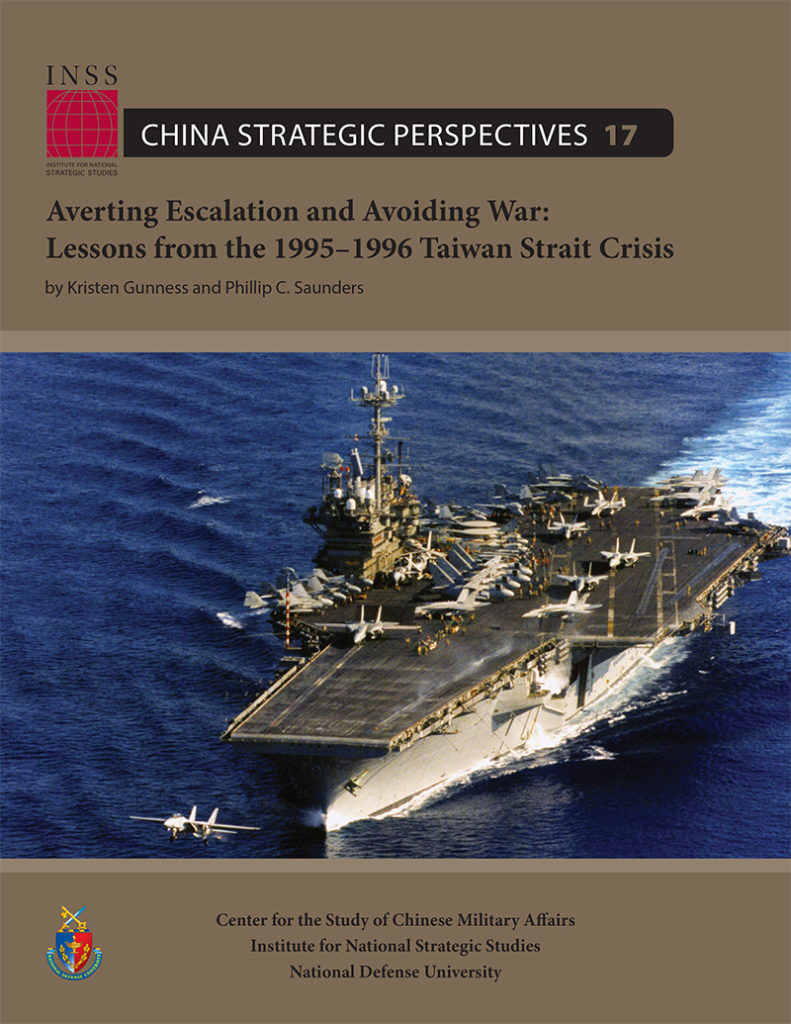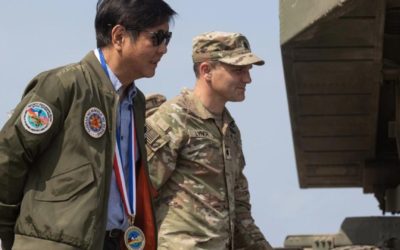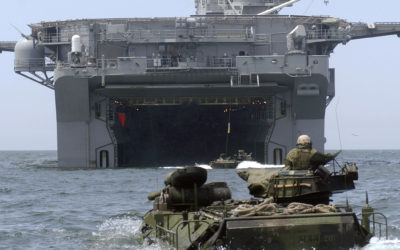On April 26, U.S. President Joe Biden welcomed South Korean President Yoon Suk-yeol to the White House for a summit meeting to celebrate the seventieth anniversary of the U.S.-South Korea alliance and open a new chapter for the next seventy years of expanded cooperation. Amid a substantial list of topics discussed by the two leaders, extended deterrence emerged as the top deliverable.
Averting Escalation and Avoiding War: Lessons from the 1995–1996 Taiwan Strait Crisis
Averting Escalation and Avoiding War: Lessons from the 1995–1996 Taiwan Strait Crisis
Averting Escalation and Avoiding War: Lessons from the 1995–1996 Taiwan Strait Crisis
Executive Summary
This study assesses information-sharing, communication, and policy coordination between U.S. and Taiwan decision makers in the 1995–1996 Taiwan Strait Crisis, derives key lessons, considers the implications for a future crisis, and makes recommendations to policymakers.
Crisis Origins
The crisis began with (1) the U.S. decision in May 1995 to reverse previous policy and grant Taiwan President Lee Teng-hui a visa to make a speech at Cornell University in June 1995, and (2) China’s internal debate about how to respond.
Why Did China Adopt a Coercive Strategy?
- China and Taiwan had divergent objectives for cross-strait relations.
- Taiwan’s democratization and “pragmatic diplomacy” were viewed by China as movements toward independence.
- China perceived a weakening of the U.S. commitment to its “one-China” policy.
- People’s Republic of China President Jiang Zemin was politically weak relative to Taiwan policy hardliners.
China’s strategic goals during the crisis included: (1) coercing the United States into ending tacit support for Taiwan independence and returning to its one-China policy, (2) coercing Taiwan into abandoning efforts to redefine its status and expand its international space, and (3) eroding political support for President Lee and pro-independence forces in Taiwan.
China’s Actions During the Crisis
- Beijing suspended cross-strait dialogue, downgraded U.S.-China diplomatic contacts, and pressured the United States to set limits on future visits by Taiwan leaders.
- The People’s Liberation Army (PLA) conducted six ballistic missile launches near Taiwan in July and live-fire exercises in the Taiwan Strait in August.
- After receiving assurances that future visits would be limited and a summit meeting between the U.S. and Chinese presidents on October 24, China intensified its focus on Taiwan.
- The PLA conducted a major naval exercise in October and an amphibious landing exercise on Dongshan Island in November, prior to Taiwan’s legislative elections.
- The PLA conducted ballistic missile launches near Taiwan ports and a large joint amphibious landing exercise in the Taiwan Strait prior to the March 1996 Presidential election.
U.S. Responses to China’s Actions
- The initial U.S. response consisted of restrained diplomatic criticism and a focus on restoring normal working relations with China, in the interest of pursuing various U.S. interests.
- Concerns about the potential impact of China’s exercises on U.S. credibility led President Bill Clinton to deploy two aircraft carrier battle groups near Taiwan in March 1996 to send a strong military signal while managing escalation risks.
- Factors shaping the U.S. responses included: (1) bureaucratic disagreements and lack of one voice on China policy, (2) the need to maintain U.S. credibility in the region, (3) the intelligence consensus that China was conducting a show of force rather than preparing to use force, and (4) limited PLA capabilities.
Taiwan’s Responses to Chinese Actions
- The initial response focused on downplaying the threat, increasing military readiness, rejecting Chinese demands, and publicizing Taiwan military exercises to reassure the public.
- Preparations for the PLA March 1996 exercises included resupplying and strengthening island garrisons, establishing a high-level crisis management group, reassuring the public, and stressing tight adherence to rules of engagement to control escalation risks.
U.S.-Taiwan Communications and Coordination
- Routine intelligence-sharing and security cooperation mechanisms functioned effectively.
- The United States and Taiwan employed three main communications channels:
- A Foreign Ministry–State Department channel, via the American Institute in Taiwan (AIT) and Taipei Economic and Cultural Representative Office (TECRO)
- The AIT Taipei end functioned effectively but had a limited ability to shape Lee Teng-hui’s decisions.
- There were significant challenges at the TECRO Washington end, especially after TECRO Representative Benjamin Lu’s access was limited following Lee’s visit.
- A Pentagon-TECRO Military Mission channel, which included some information- sharing and one direct consultation about rules of engagement and escalation management
- A new National Security Council–level “special channel,” which involved secret consultations at the national security advisor level in March 1996.
- A Foreign Ministry–State Department channel, via the American Institute in Taiwan (AIT) and Taipei Economic and Cultural Representative Office (TECRO)
- There was very limited U.S.-Taiwan policy coordination, which was achieved only at the end of the crisis through the special channel.
Lessons Learned from the Crisis
- U.S. and Taiwan security concerns sometimes diverged. Taiwan leaders worried about potential PLA seizure of outlying islands, which might require escalatory military responses, but U.S. policymakers did not fully understand or share these concerns.
- Having an authoritative high-level communications channel was important.
- Limited PLA capabilities made analytic consensus easier.
- Bureaucratic differences, including divergent agendas and priorities, can affect decision-making during a crisis.
- It can be dangerous to lose focus on the Taiwan issue.
- Distrust in the U.S.-Taiwan relationship negatively affected information-sharing and policy coordination during the crisis.
- China sought to exploit differences in U.S. and Taiwan interests.
- Chinese policymakers had a limited understanding of how domestic politics influence policymaking in democratic systems.
- Chinese policymakers felt that they had higher stakes and greater resolve in a crisis over Taiwan but did not fully understand how U.S. regional interests and alliance commitments would affect U.S. decisions.
Now Versus Then: Key Changes Since the 1995–1996 Crisis
- There is heightened U.S.-China strategic competition, and the United States is focusing more on China than it did in the past.
- The PLA has new capabilities at both the low and high ends of the spectrum, providing the Chinese Communist Party with many more military options. ■ The PLA has developed counter-intervention capabilities.
- The arrival of informationized warfare has brought increased escalation risks.
- China has experienced a turn toward authoritarianism and a centralization of power.
- Taiwan has experienced a consolidation of democracy, intensification of a sense of separate identity, and declining interest in unification.
- There is a more open media and Internet environment in Taiwan.
- There is intense partisanship and an increase in isolationist sentiment in the United States.
Implications for Policymakers
- Improved and more diverse PLA capabilities will make it harder to determine China’s intentions and are likely to result in delayed and ambiguous warning.
- Higher costs and risks of military action and ambiguous warning will make it harder for policymakers to decide when to act and to determine an appropriate response, even as time pressures to begin moving military forces mount.
- Incentives for consultation and policy coordination are stronger today, when the United States and Taiwan would be facing a credible PLA threat rather than a show of force.
There are significant impediments to consultations and policy coordination, including differences in U.S. and Taiwan interests, the degree of trust between U.S. and Taiwan leaders, and concerns about shared intelligence or plans being leaked for political reasons or obtained by Chinese intelligence.
Recommendations for Policymakers
- Discuss differences between broader U.S. regional interests and equities and Taiwan’s narrower political, economic, and security interests frankly, and seek to limit China’s ability to exploit these differences in peacetime, crisis, and conflict. This may require sharing more information on each side’s conversations with China, especially in a crisis.
- Consult in advance on major policy initiatives that may have a significant impact on Sino-U.S. relations or cross-strait relations. Both sides should practice the principle of “no surprises.”
- Exercise great caution in lobbying efforts or contacts with the opposition party to pressure the government in power. Such actions can erode trust and impede cooperation in a crisis.
- Increase bilateral cooperation on cybersecurity, information warfare, and countering Chinese propaganda. Taiwan is on the front lines in confronting these threats; the United States should support and learn from Taiwan’s defensive measures.
- Conduct regular intelligence consultations on Chinese strategic intentions and joint analysis of PLA force posture, exercises, and capabilities to improve assessments of Chinese military capabilities and identify potential indicators of military attack, especially in terms of intelligence and cyber preparation of the battlefield.
- Restore wargaming/crisis simulation exercises to the Monterey Talks to improve mutual understanding of the other side’s security perceptions, crisis communications mechanisms, and decision-making procedures.
- Develop and maintain a common threat picture as a crisis begins to emerge, conducting regular discussion of assessments of Chinese intentions and of circumstances that might lead one side to consider unilateral military actions.
- Distinguish areas where active U.S.-Taiwan military coordination would be necessary in a crisis or conflict from areas where coordination is unnecessary or where deconflicting operations would be sufficient.
- Consider what types of additional military, policy, and intelligence information could be shared in a crisis and how that information should be protected.
- Identify trusted liaison officers in AIT and TECRO who would be conduits for information that each side’s crisis management group decides to share.
This article was republished in California as a work of the United States government from the National Defense University to point warfighters and national security professionals to reputable and relevant war studies literature. Read the report.

Ms. Kristen Gunness is a senior policy researcher at RAND. Her background includes military, security, and foreign policy issues in the Indo-Pacific, with focuses on China and deterrence and escalation management in the region. She has worked with a range of Department of Defense and private-sector clients throughout her career and advised senior leaders in the U.S. Navy, U.S. Indo-Pacific Command, Office of the Secretary of Defense, and the Intelligence Community. Before joining RAND, Ms. Gunness served as the director of the Navy Asia Pacific Advisory Group at the Pentagon, where she advised the Chief of Naval Operations on security and foreign policy trends in the Indo-Pacific region with a focus on Chinese maritime strategy and naval capabilities. Prior to her position on the Navy staff, she was senior project director on Chinese military and security affairs at CNA. Ms. Gunness holds a Master of Arts in Security Studies from Georgetown University’s Walsh School of Foreign Service and a certificate in Chinese Studies from Hopkins-Nanjing Center in the School of Advanced International Studies at The John Hopkins University.
Dr. Phillip C. Saunders is Director of the Center for the Study of Chinese Military Affairs and a distinguished research fellow in the Institute for National Strategic Studies at the National Defense University. He previously worked at the Center for Nonproliferation Studies from 1999 to 2004 and served as an officer in the U.S. Air Force from 1989 to 1993. Dr. Saunders received his Ph.D. from the Princeton School of Public and International Affairs. He is co-author with David Gompert of The Paradox of Power: Sino-American Strategic Restraint in an Era of Vulnerability (NDU Press, 2011) and has edited nine books on Asian security issues, including Crossing the Strait: China’s Military Prepares for War with Taiwan (NDU Press, 2022).
Related Articles
President Marcos Jr. Meets With President Biden—But the U.S. Position in Southeast Asia is Increasingly Shaky
Over a four-day visit to Washington, Philippine President Ferdinand Marcos Jr. has been welcomed to the White House and generally feted across Washington. With President Biden, Marcos Jr. (whose father was forced out of office in part through U.S. pressure, and whose family has little love for the United States) affirmed that the two countries are facing new challenges, and Biden said that “I couldn’t think of a better partner to have than [Marcos Jr.].”
The U.S. is about to blow up a fake warship in the South China Sea—but naval rivalry with Beijing is very real and growing
As part of a joint military exercise with the Philippines, the U.S. Navy is slated to sink a mock warship on April 26, 2023, in the South China Sea.
The live-fire drill is not a response to increased tensions with China over Taiwan, both the U.S. and the Philippines have stressed. But, either way, Beijing isn’t happy – responding by holding its own staged military event involving actual warships and fighter jets deployed around Taiwan, a self-governed island that Beijing claims as its own.




